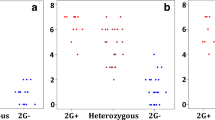Abstract
A set of experimental introgression lines of Triticum aestivum L. cv. Novosibirskaya 67 (N67)—Triticum polonicum L. line IC 12196 was developed using a small-scale bulk breeding method. The linkage map in chromosome 7A was constructed using F2 hybrids of N67/IC12196 and 34 microsatellite markers. The P gene was flanked by the centromeric markers, Xgwm890 (18.6 cM) and Xbarc108 (20.0 cM) on the long arm of chromosome 7A. Among 124 introgression lines, 118 lines were hexaploid (2n = 6x = 42), and 6 were tetraploid (2n = 4x = 28). Among hexaploid accessions, 68 were long-glumed, whereas 50 were normal-glumed. Thirty-four polymorphic microsatellite markers were scored for either the N67 alleles or IC 12196 alleles in 124 introgression lines derived from N67/IC 12196. The UPGMA dendrogram showed five clusters; Cluster 1 mainly contained hexaploid introgression lines with long glumes. Although the alleles around the P locus were recombined with IC1296 alleles, the distal end of the chromosome contained N67 alleles. Cluster 2 mainly contained normal glumed, hexaploid introgression lines. These predominantly had the N67 alleles on the long arm of chromosome 7A and the short arm proximal to the centromere. Cluster 3 contained long-glumed, hexaploid wheat lines with relatively high level of recombination. Cluster 4 contained non-parental alleles. Cluster 5 contained the group of tetraploid wheat lines. These tetraploid lines have IC12196 alleles on both arms of chromosome 7A. The frequency spectrum of parental alleles and chromosomal blocks among introgression lines suggested that T. aestivum – T. polonicum hybridization can rapidly give rise to a new landrace due to selective introgression of the P gene.





Similar content being viewed by others
References
Akond ASMGM, Watanabe N (2005) Genetic variation among Portuguese landraces of ‘Arrancada’ wheat and Triticum petropavlovskyi by AFLP-based assessment. Genet Resour Crop Evol 52:619–628
Akond ASMGM, Watanabe N, Furuta Y (2008) Comparative genetic diversity of Triticum aestivum–Triticum polonicum introgression lines with long glume and Triticum petropavlovskyi by AFLP-based assessment. Genet Resour Crop Evol 54:133–144
Alston FH, Jones JK (1968) Variation in transmission of univalent chromosomes from pentaploid wheat hybrid. Can J Genet Cytol 10:908–912
Dellaporta SL, Wood J, Hicks JB (1983) A plant DNA minipreparation: version II. Plant Mol Biol Rep 1:19–21
Erayman M, Sandhu D, Sidhu D, Dilbirligi M, Baenzigeret PS et al (2004) Demarcating the gene-rich regions of the wheat genome. Nucleic Acids Res 32:3546–3565
Faris JD, Haen KM, Gill BS (2000) Saturation mapping of a gene-rich recombination hot spot region in wheat. Genetics 154:823–835
Kihara H (1924) Cytologische und genetische Studien bei wichtigen Getreidearten mit besonderer Rücksicht auf das Verhalten der Chromosomen und die Sterilität in den Bastarden. Mem Coll Sci Kyoto Imp Univ Ser B 1:1–200
Kihara H, Wakakuwa S (1935) Weitere Untersuchungen über die pentaploiden Triticum-Bastarde. IV. Jpn J Bot 7:381–387
Kosambi DD (1944) The estimation of map distances from recombination values. Ann Eugenics 12:172–175
Kosuge K, Watanabe N, Kuboyama T, Melnik VM, Rosova MA, Yanchenko VI, Goncharov NP (2008) Cytological and microsatellite mapping of mutant genes for spherical grain and compact spikes in durum wheat. Euphytica 159:289–296
Lukaszewski A, Curtis CA (1993) Physical distribution of recombination in B-genome chromosome of tetraploid wheat. Theor Appl Genet 86:121–127
Raquin A-L, Brabant P, Rhoné B, Balfourier F, Leroy P, Goldringer I (2008) Soft selective sweep near a gene that increases plant height in wheat. Mol Ecol 17:741–756
Röder MS, Korzun V, Wendehake K, Plaschke J, Tixier M-H, Leroy P, Ganal MW (1998) A microsatellite map of wheat. Genetics 149:2007–2023
Saintenac C, Falque M, Martin OC, Paux E, Feuillet C, Sourdille P (2009) Detailed recombination studies along chromosome 3B provide new insights on crossover distribution in wheat. Genetics 108:393–402
See DR, Brooks S, Nelson JC, Brown-Guedira G, Friebe B et al (2006) Gene evolution at the ends of wheat chromosomes. Proc Natl Acad Sci USA 103:4162–4167
Sidhu D, Gill KS (2004) Distribution of genes and recombination in wheat and other eucaryotes. Plant Cell Tissue Organ Cult 79:257–270
Song QJ, Shi JR, Singh S, Fikus EW, Costa JM, Lewis J, Gill BS, Ward R, Cregan PB (2005) Development and mapping of microsatellite (SSR) markers in wheat. Theor Appl Genet 110:550–560
Torada A, Koike M, Mochida K, Ogihara Y (2006) SSR-based linkage map with new markers using an intraspecific population of common wheat. Theor Appl Genet 112:1042–1051
Ungerer MC, Baird SJE, Pan J, Rieseberg LH (1998) Rapid hybrid speciation in wild sunflowers. Proc Natl Acad Sci USA 95:11757–11762
Wang H-J, Huang X-Q, Röder MS, Börner A (2002) Genetic mapping of loci determining long glumes in the genus Triticum. Euphytica 123:287–293
Watanabe N (2004) Triticum polonicum IC12196: a possible alternative source of GA3-insensitive semi-dwarfism. Cereal Res Commun 32:429–434
Watanabe N, Imamura I (2002) The inheritance and chromosomal location of a gene for long glume phenotype in Triticum petropavlovskyi Udacz et Migusch. J Genet Breed 57:221–227
Watanabe N, Yotani Y, Furuta Y (1996) The inheritance and chromosomal location of a gene for long glume in durum wheat. Euphytica 91:235–239
Watanabe N, Bannikova SV, Goncharov NP (2004) Inheritance and chromosomal location of the genes for long glume phenotype found in Portuguese landraces of hexaploid wheat, “Arrancada”. J Genet Breed 58:273–278
Acknowledgments
N. Watanabe acknowledges Dr M.S. Röder, IPK Gatersleben for providing us unpublished primer sequences of microsatellite markers. A part of this study was done at the experimental facility of the Faculty of Applied Biological Sciences, Gifu University, Gifu, Japan.
Author information
Authors and Affiliations
Corresponding author
Rights and permissions
About this article
Cite this article
Kosuge, K., Watanabe, N. & Kuboyama, T. Recombination around the P locus for long glume phenotype in experimental introgression lines of Triticum aestivum – Triticum polonicum . Genet Resour Crop Evol 57, 611–618 (2010). https://doi.org/10.1007/s10722-009-9499-y
Received:
Accepted:
Published:
Issue Date:
DOI: https://doi.org/10.1007/s10722-009-9499-y



